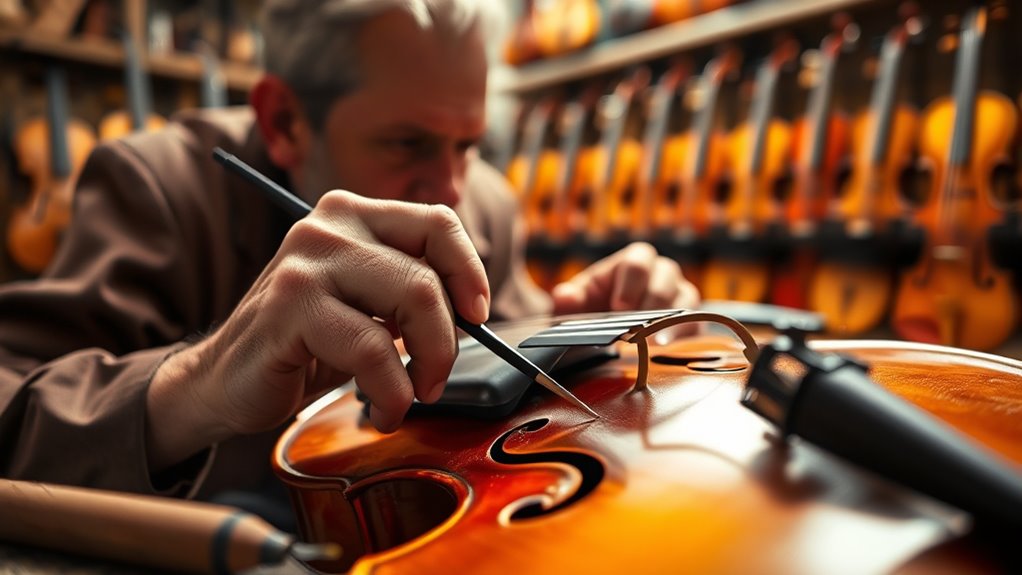The craftsmanship of Cremona violins is a living heritage that combines centuries-old traditions with innovative techniques. As a listener or musician, you’ll notice how master luthiers carefully select aged woods, shape each instrument by hand, and uphold centuries of skill passed down through generations. Their dedication preserves a cultural legacy while adapting to modern demands for sound quality and durability. If you want to explore how this timeless craft continues to inspire today, there’s much more to discover.
Key Takeaways
- Cremona luthiers preserve centuries-old violin-making traditions while integrating innovative techniques to meet modern sound and durability standards.
- Their craftsmanship combines meticulous hand carving, selection of aged high-quality woods, and traditional finishing methods.
- Master luthiers view themselves as custodians of a cultural legacy, ensuring the authenticity and continuity of Cremona’s violin-making heritage.
- Each violin embodies a blend of tradition, innovation, and detailed skill, making it a unique piece of living cultural history.
- The craftsmanship sustains Cremona’s reputation as a worldwide center of master violin-making, inspiring musicians and preserving a rich artistic legacy.

Cremona violins are renowned for their exceptional craftsmanship, a skill passed down through generations of master luthiers. These artisans have dedicated their lives to perfecting the art of violin making, guaranteeing that each instrument embodies a blend of tradition, innovation, and meticulous attention to detail. Their work is not just about creating beautiful sounds; it’s about preserving a rich history rooted in centuries of craftsmanship that continues to thrive today. As you explore Cremona’s violin-making legacy, you realize how essential their commitment is to history preservation. These master luthiers see themselves as custodians of a cultural heritage, maintaining techniques and standards that have been refined over hundreds of years. They don’t just make violins; they uphold a tradition that links the past with the present, guaranteeing the authenticity and uniqueness of each instrument.
Cremona master luthiers preserve centuries-old violin-making traditions with meticulous craftsmanship and innovative techniques.
You’ll notice how these master luthiers approach their craft with reverence for tradition, yet they’re also open to innovation. They understand that preserving history doesn’t mean resisting change but rather respecting the foundations while adapting to modern techniques and materials. This balance allows them to produce violins that resonate with the spirit of their ancestors while meeting contemporary demands for sound quality and durability. Their craftsmanship is a proof of their dedication, patience, and skill—qualities that are evident in the exquisite finish, precise carving, and perfect acoustics of each violin they produce.
As you observe their work, you see how master luthiers carefully select the finest woods, often aged for years to enhance tonal quality. They shape and carve each piece by hand, relying on time-honored methods passed down through generations. Their intimate knowledge of wood properties, acoustics, and varnishing techniques ensures that every violin is a unique masterpiece. Despite advances in technology, many artisans still prefer traditional handcrafting methods, emphasizing the importance of history preservation in their craft. This dedication to authenticity means that each Cremona violin isn’t just an instrument—it’s a piece of history, a living proof of the skill and passion of master luthiers.
Ultimately, you see that the craftsmanship of Cremona violins is more than a skill; it’s a living heritage. Each violin tells a story of centuries-old tradition, the tireless work of master luthiers committed to excellence, and a cultural legacy that continues to inspire musicians worldwide. Their craftsmanship keeps the spirit of Cremona alive, guaranteeing this storied art form endures for generations to come.
Frequently Asked Questions
How Do Cremona Violin Makers Authenticate Their Instruments?
You can authenticate Cremona violins by checking for genuine violin authenticity features, like labels and craftsmanship details. Cremona certification plays a crucial role, as it verifies the instrument’s origin and authenticity. Expert luthiers examine the wood, craftsmanship, and labels to guarantee the violin’s genuineness. Always consult a trusted appraiser or specialist familiar with Cremona violins to confirm the instrument’s provenance and secure your investment.
What Are the Modern Challenges Faced by Cremona Luthiers?
You face modern challenges like fierce market competition and sourcing quality materials. As a Cremona luthier, you must stand out amid many skilled artisans while ensuring your wood and varnishes meet traditional standards. Limited access to rare materials pressures you to innovate without compromising craftsmanship. Balancing tradition with modern demands, you need to adapt your techniques and materials to stay relevant and preserve the heritage of Cremona violin making.
How Has Digital Technology Impacted Traditional Cremona Violin Craftsmanship?
Digital innovation has greatly impacted traditional Cremona violin craftsmanship by offering new tools for precision and design. You can now access detailed tutorials, 3D modeling, and digital measurement techniques that enhance craftsmanship preservation. While some worry about losing the artisanal touch, embracing these technologies helps you refine skills, streamline processes, and guarantee the heritage endures for future generations without compromising the essence of traditional craftsmanship.
Are Cremona Violins More Valuable Than Other Italian Violins?
Of course, Cremona violins outshine others in the Italian domain, thanks to their legendary craftsmanship. You’ll find that their historical valuation and market demand skyrocket, making them more valuable than most. While other Italian violins hold charm, Cremona’s rich heritage and reputation guarantee their premium status. So, if you’re after investment or prestige, these exquisite instruments practically write their own ticket in the world of fine violins.
What Are the Environmental Factors Affecting Cremona Violin Preservation?
You need to manage humidity levels carefully to preserve your Cremona violin, as fluctuations can cause cracking or warping. Keep pests like wood-boring insects at bay through pest management, since they can damage the instrument’s delicate wood. Store your violin in a stable environment, avoiding extreme temperature changes and direct sunlight, to maintain its quality and longevity. Proper environmental control guarantees your Cremona violin remains in excellent condition for years to come.
Conclusion
As you explore the craftsmanship of Cremona violins, you realize it’s like holding a piece of living history in your hands. Each luthier’s skill and dedication breathe life into these instruments, making them timeless treasures. Their artistry is as intricate as a finely woven tapestry, ensuring that this heritage endures for generations. By appreciating their craftsmanship, you become part of a tradition that’s as vibrant and enduring as the music it produces.








